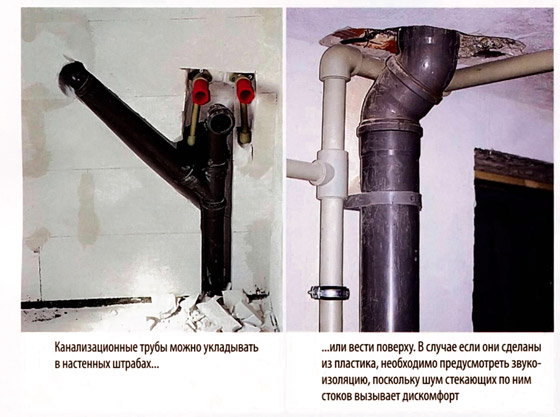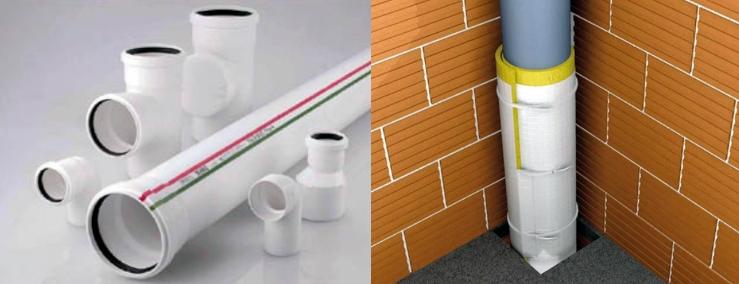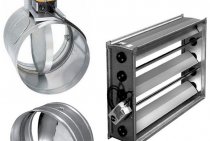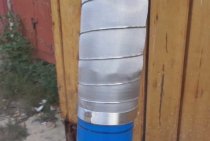Installation of a sewer system
First, the axes of the pipelines are marked. Then fasteners are mounted, assemblies are assembled from fittings, pipes and pipes. The correctness in horizontal and vertical arrangements is checked. Mounting is being done.
Cutting the pipe "to size" is carried out immediately before installation, so that there is the possibility of "fitting".
Cutting into pieces of a given length, while installing water and sewer pipes, is done with an ordinary hacksaw. The end face is cleaned with a needle file, a chamfer is removed at an angle of 15o.
It is unacceptable to place socket connections between floors, to change the angle of inclination from the calculated one in horizontal sections.
Methods for laying sewer pipes
Installation of a new system begins with sealing the socket of the first element on the riser tee, taking into account the angle of the pipeline. Fixation is made with fixing clamps to the wall or to the floor.
The parts to be joined must be clean and without visible damage and deformations in diameter. Rejection should be made at the acquisition stage.
The installation of plastic sewer pipes is carried out so that the smooth end does not enter the socket all the way. Temperature fluctuations and, as a result, a change in the length of the pipe should be taken into account. A compensation gap of 10 mm will provide the system with tightness in case of temperature changes. With a pipe length of 3-10 m, compensation couplings are used.
Reliability of docking will give silicone sealant. Sealant lubricates the outer part of the pipe (you can not use grease inside).
During installation, it is important to comply with the requirements for the slope of sewer pipes. The use of sound-absorbing pipes (longitudinal stripes of green and red) will reduce the complexity of installing the sewerage system
But one should take into account the high cost of such products.
The use of sound-absorbing pipes (longitudinal stripes of green and red) will reduce the complexity of installing the sewerage system. But you should take into account the high cost of such products.
Noise control: sound-absorbing pipes and sewer pipe soundproofing
Therefore, to reduce sound from sewage drains, the pipe can be insulated. Risers located close to the bedrooms, kitchen or living room need soundproofing. If the riser passes in a place remote from the constant presence of people, then the need for protection against sound vibrations is eliminated.
The assembled system must be checked for leaks. Having collected water in buckets in advance, you need to sharply pour it into the tested device: washbasin, sink, bathtub. The leak should be dismantled and sealed again.
Instructions for assembling sewer pipelines (in text or video formats) will allow you to avoid further operation of the cleaning system, noise from the movement of drains, repair of deformed elements and other unpleasant moments.
Installation of ductile iron pipes for RJ connection Watch this video on YouTube
There are several ways to connect. Thanks to a wide range of options, it becomes possible to choose the most suitable method, taking into account the operating conditions of the pipeline. Overview of connection types:
- Trumpet. Communications in this case have an extension on one side. It looks like a cuff. A rubber gasket is installed in the socket. Then a pipe is inserted into this expansion. The result is a reliable, durable connection. However, its quality is determined by the characteristics of the gasket. If the rubber deforms or loses its properties, which often happens during prolonged use, then a leak will form. You can fix it by replacing the gasket.
- sealing method. In this case, communications with a socket are used, however, the gasket is not installed at the joint area.The cracks are filled with tow, after which they are cemented.
- Socketless connection. In this case, an adapter in the form of a coupling is used. Communications are installed in this product from two sides. Then, in this section, the pipeline elements are coupled with metal clamps.
- Plastic joint. Docking according to this principle is performed when it is necessary to connect sections of cast iron and plastic pipelines. To do this, use special adapters, sealant.
Chasing a cast iron pipe
To chisel a cement-coated sewer pipe, remove the seal with a special hammer. Strong blows are unacceptable, the cement is chipped in small pieces. After that, the edge of the cable is searched (a rope wrapped around the pipe to enhance tightness) and an attempt is made to unwind it. There is no need to pull out the entire cable, it is enough to slightly free up space and loosen the cast-iron pipe entering the socket. It is most convenient to pull out the rope with a hook, if there is an opportunity (free space), then a screwdriver is squeezed into the gap between the socket and the nozzle. Only after the pipe begins to sway is it allowed to pull the cast-iron pipe out of the socket. To do this, it is pulled back in the transverse direction and scrolls in the end.
If there are difficulties during the caulking process (the pipe remains stationary or a significant effort is required to loosen it), then this is due to two possible reasons:
- pipes have grown together during operation;
- for sealing, they used not a cable with cement, but sulfur.
In the first case, it remains only to cut off the cast-iron pipe with a grinder directly above the socket, then make 2-3 internal notches with a disk with a smaller diameter
The remains are carefully chipped off with a chisel, it is important to avoid getting metal elements into the sewer. After that, the inside of the bell is cleaned and wiped dry with a rag
It is more difficult to disassemble sewer cast-iron pipes with a sulfur plug, heat treatment of the joint area is required - heating with a blowtorch to several hundred ° C, the desired state is determined visually (the pipe will turn red). In this case, the sealant burns out and the pipe becomes free. An important nuance: it is allowed to remove the cast-iron sewer pipe no earlier than 15 minutes after heating, it is impossible to loosen and influence hot joints. effort and pressure).
The toilet is replaced according to the same rules. It is recommended to follow simple rules: disconnect the water supply, drain the tank to the maximum and disassemble the toilet. When fastened with studs or a nut connection, it is easier to replace the toilet bowl with your own hands: it is unscrewed, loosened and removed from the outlet pipe. It is almost impossible to remove the toilet bowl installed on the cement mortar intact, in this case it simply breaks.
It is strictly forbidden to hit the sewer pipe, this is the same as directly hitting cast iron with a sledgehammer. Therefore, blows are applied to the neck, and then the toilet bowl is broken into pieces. At the moment the base is detached, water flows out of it, it is advisable to prepare rags and a bucket in advance to collect it. Be sure to clean the edges of the sewer cast-iron pipe from pieces of faience. This is done with a chisel or screwdrivers, this stage is very important (the pipe goes into the floor, problems arise if it is damaged). In the area of special risk are common risers with tees (with cast-iron wiring to the bath) and old toilets with cemented joints, in this case it is better to entrust the caulking to specialists.
WATCH VIDEO
Start and sequence of repairs
The easiest way to dismantle a cast-iron sewer is to cut it with a grinder or gas cutter. But it is unacceptable when repairing with the involved risers of neighboring apartments or replacing the toilet. Some of the problems are eliminated if the method of chasing is known in advance, but more often it is found out in the process of disassembling the system. Before starting work, the water supply line must be turned off. In general, chasing cast-iron pipes with your own hands takes place in the following sequence:
- Visual inspection of the sewer and clarification of the degree of complexity of the work.
- Determination of the minting method by tapping the cork.
- Directly chasing the sockets of sewer pipes.
- Cleaning up the remaining area.
- Replacing a new section and hiding the seams of the joints.
Security measures
When installing a cast-iron pipeline, care must be taken with such products. Cast iron is reliable and durable in operation, but it is a fragile material, which manifests itself during transportation and installation.
During cutting, small pieces of metal may break off. When they enter the pipeline, they contribute to a decrease in the clearance. In addition, fragments can get into the face, injure the organs of vision. For this reason, it is recommended to wear a protective screen or goggles while working with cast iron communications.
If pipe cutting is carried out in a room with installed plumbing fixtures and furniture, it is necessary to maintain their integrity. To do this, before starting dismantling, cover all objects with a dense cloth.
Features of the use of cast iron in drainage systems
Despite their significant weight, cast iron sewer pipes continue to be used due to a number of important technical characteristics:
- increased strength:
- high resistance to wear;
- resistance to corrosion;
- good soundproofing properties;
- low coefficient of thermal expansion;
- good casting qualities;
- incombustibility and fire resistance;
- environmental safety - during their operation, the release of toxic substances does not occur.
The service life of cast iron sewer pipes can reach 100 years. The service life of cast iron pipes is extended by additional treatment of products with an anti-corrosion coating - petroleum bitumen or high-strength white cast iron. Cast iron sewer pipes are used for the installation of pressure internal and external drainage systems, non-pressure networks and drains.
In sewer systems, in which the load is much higher than in ordinary household networks, a cast-iron sewer pipe DN 150 and sewer cast-iron pipes 200 mm are used.
These pipes have been used:
- at points of public catering, in the food industry, in the production of beverages;
- at large slaughterhouses, farms and other places associated with keeping animals, meat processing plants;
- in sanatoriums with access to thermal and mineral waters;
- in medical and educational institutions;
- in laboratories.
Assortment of cast-iron pipes and fittings for network installation
The diameter of a cast-iron sewer pipe is 50-150 mm, pipes made of ductile iron - up to 500 mm. For pipes with a diameter of 50-150 mm, the gap width should be 5-6 mm. From sinks, toilet bowls and bathtubs, pipes with a diameter of 50 mm are used for draining, and 100 mm for risers.
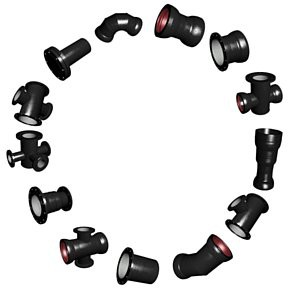
- couplings connecting straight sections of the pipeline of the same diameter and transitions of diameters;
- bends (elbows) intended for turns of pipelines;
- tees and crosses serving for branched sections;
- crosses that serve to divide the site into two branches;
- plugs and plugs intended for temporary or permanent closure of pipeline branches.
Pipe production
Cast iron is a material produced from the processing of iron ore. The difference in making iron and steel is the high amount of carbon. For the production of high-quality cast iron products, two methods approved by the guest are used:
- Continuous casting method. The manufacturing process consists in pouring liquid material into a mold, in which it changes consistency. In the mold, cast iron hardens and is drawn into pipes of the required parameters.
- Centrifugal casting method. Liquid iron is placed in rotating molds until solidified. This method can produce pipes of almost any plane with symmetry. The wall thickness depends on the mass of liquid iron.
Pipes of our generation are distinguished by a beautiful shade, additional protective treatment on the inside and outside.
